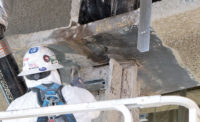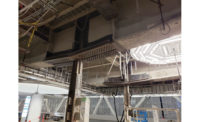The American Institute of Steel Construction’s task group reviewing the conditions that led to the failure of built-up plate girders in San Francisco’s Salesforce Transit Center is not only considering changes in steel standards, but also the twin girders’ design detail at the site of the brittle fractures. The AISC team will also look into a similar girder failure, since repaired, at the SoNo Collection shopping mall in Connecticut.
The AISC ad hoc task group “is looking at more than the Metropolitan Transportation Commission's peer review panel report,” says Charlie Carter, AISC’s president. “There are other issues” under the lens, including the design detail, he adds.
The 1.2-million-sq-ft bus depot, owned by the Transbay Joint Powers Authority, reopened last July 1, after a nine-month closure that included repairs to the girders’ bottom flanges, which fractured in 2018. The area's Metropolitan Transportation Commission (MTC) convened the independent panel soon after the September 2018 discovery of bottom-flange fractures in twin tapered girders over Fremont Street. The 4.5-block-long building, designed by Pelli Clarke Pelli Architects with structural engineer Thornton Tomasetti, had been open for less than two months.
MTC Panel Recommendations
The MTC panel, which released its final report in late February, recommended, among other things, that AISC reevaluate the standard quarter-down sampling location for thick-plate quality testing for fracture toughness and the number of test samples required. Also, the group is asking AISC to clarify the definition of weld access hole, reconsider the adequacy of grinding requirements and develop a risk-assessment approach to evaluate brittle-fracture conditions.
The AISC group, convened shortly after MTC issued its report, is considering standards, materials, design and fabrication. The group also is exploring the transit center failures in the context of the principles and practices that have been learned from past research and experiences with fractures, says Lawrence F. Kruth, AISC’s vice president of engineering and research.
Each of the girders, fabricated by Herrick Corp., spans about 87 ft to help support a rooftop park directly above and pick up a second-floor bus deck below. Each girder picks up the bus deck via a hanger plate that thickens the web at its 8-ft-deep midspan and slots through the bottom flange, a shallow V in profile. A pair of nearly identical girders span First Street nearby. Their bottom flanges did not fracture.
Duane Miller, of Lincoln Electric, is the chair of the AISC group, which is working pro bono. Other members are Rob Connor, from Purdue University; Jim Fisher, a past chair of the AISC specification committee; Chris Hewitt of Simpson Gumpertz & Heger; Larry Muir, a consultant; Tom Murray, of Virginia Tech, Tom Schlafly, representing AISC, Jim Schoen, of Nucor-Yamato Steel and AISC's Eric Bolin, the group's secretary.
Hanger Slots Through Bottom Flange
The AISC probe will consider the design of the hanger detail that thickens the web and slots through the bottom flange. “Is it similar to other details or does it introduce something new?” Carter asks. “There’s another [fracture] case in a project in Connecticut,” with a similar girder design detail by the same structural engineer, but with a different fabricator, he adds.
The Connecticut project is the 1-million-sq-ft SoNo Collection, a shopping mall in the South Norwalk neighborhood of Norwalk. The three-level enclosed mall development by Brookfield Properties includes an eight-level parking structure, with 3,040 spaces.
Construction by the VCC/KBE, a Joint Venture, started in late 2017. The mall, currently closed because of the COVID-19 pandemic, opened last Oct. 11. The architect is CallisonRTKL, Washington, D.C. The structural engineer is Thornton Tomasetti. The steel fabricator is United Steel Inc., East Hartford, Conn.
Details Not Available
Details of the mall’s girder system and the failure or failures are not available. “Due to provisions in the agreements between the owner and VCC/KBE, a Joint Venture, and our subcontractors, we are unable to release any information regarding the project or property,” says Jonelle Lawhorn, director of marketing for KBE Building Corp., Farmington, Conn.
Michael J. Squarzini, co-CEO of Thornton Tomasetti, also declines comment other than to say he has “confirmed with our client, Brookfield, that they do not want us discussing any aspects of their project in the press.”
United Steel could not be reached for comment.
At this time, with the task group’s work just getting underway, AISC does not have any details of the mall’s girder system. The group has met twice, including most recently virtually on April 27, and it expects to meet at least monthly.
The plan is to determine whether there should be any changes to AISC’s 360 Specification for Structural Steel Buildings, Steel Construction Manual and, if deemed necessary, the Code of Standard Practice, says Kruth.
The task group is scheduled to complete a technical bulletin by the end of 2022. The publication will contain guidance on how to proceed to avoid similar fractures.
The bulletin will be “useful to the engineering profession and the fabrication community,” says Kruth. “Longer-term, it also will be relevant to our standards and other technical information.”







